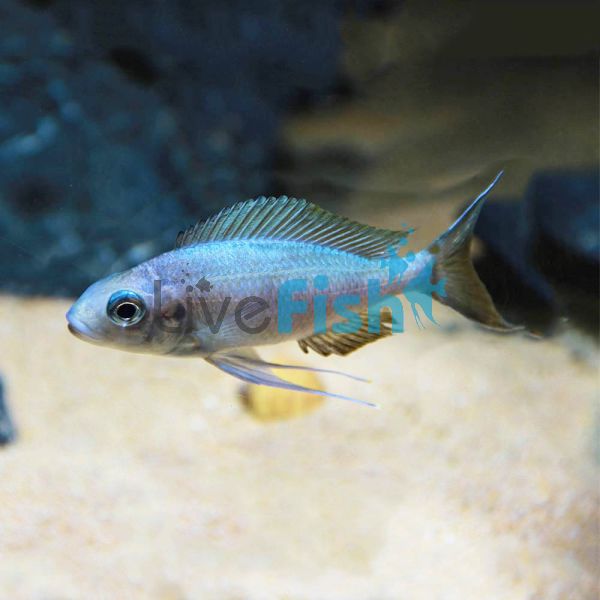Ophthalmotilapia Ventralis 5cm
Lake Tanganyika seems to have an abundance of absolutely stunning, unique, and almost saltwater-Esque species which are a spectacle to see in the home aquarium. One of these fish is the ventralis cichlid which is a great entry-level Tanganyika cichlid, these fish are active, and have a tonne of personality and unique behavioral traits which offer a lot of fun and should for sure be experienced.
- Buy 4 for $37.06 each and save 20%
- Buy 6 for $32.42 each and save 30%
Ophthalmotilapia Ventralis
Lake Tanganyika seems to have an abundance of absolutely stunning, unique and almost saltwater-esque species which are a spectacle to see in the home aquarium. One of these fish is the ventralis cichlid which is a great entry-level Tanganyika cichlid, these fish are active, and have a tonne of personality and unique behavioural traits which offer a lot of fun and should for sure be experienced. They also stay relatively small maxing out at around 15 and pretty peaceful with aggression usually just shown between males. This makes them great to be kept in a species-only colony or in a larger Tanganyikan community system. The ventralis cichlids would be a perfect breeding project for African cichlid enthusiasts or aquarists looking for a new project as well.
Though the ventralis cichlid is often referred to by its Latin name, it is also known as the feather fin cichlid which it gets due to the long, streamer-like pelvic fins. These fins can often be half the length of the fish and it gives them a very close resemblance to saltwater anthias. Ventralis cichlids are also highly popular for their powder blue colours which carry and light metallic sheen as well. This colour is practically uniform from head to tail but their fins are slightly darker with an almost ashy blue. Ventralis cichlids also have fairly large eyes compared to their head size. These cichlids are often found in shallow waters and are commonly found in regions where a rock wall meets with an open sand bed. Since ventralis cichlids often hang out near the bottom of their environment the underside of their body is fairly flat with little curves.
Breeding these fish is can be challenging but it is a very fun process. Males tend to show far more aggression and are more vibrant compared to females. Surprisingly they tend to do most of the hard work where females will lay eggs which they then mouth brood once fertilised. The issue is that for the first few times, the inexperienced pair may predate on the eggs or simply not get the process correct. Since they can be semi-aggressive, there should also be a stable ratio of males to females. It is usually best to start off with a school of 6-10 fish and then aim to keep only 1-2 males and the rest can be females.
Tank Recommendations for your Ophthalmotilapia Ventralis
The environmental conditions of this species are quite important as they can really bring out a lot of the natural behaviours which are displayed by the Ventralis cichlids. It is best to have a tank which is at least 250 litres to ensure there is enough space for an adult colony since these fish should be kept in groups. The ideal aquascape would consist of a large sand bed with rock caves near the back of the tank. This best replicates the shallow, rocky outcrops that these cichlids inhabit in the wild. Since these cichlids are from lake Tanganyika, they do require a higher PH of 7.0 - 8.5, this can be easily achieved through African cichlid conditioning salts or using crushed coral in the tank as well. These are also tropical fish which are best kept at 24-26 degrees.
Suitable Tank Buddies
The ventralis cichlid can be kept with other medium-sized African cichlids however it’s best to do so in larger tanks since this species can be territorial. Since these fish require a higher PH of around 8 the tank mates chosen should be adaptable to this.
Usually Compatible
Black Calvus, furcifer cichlids, Xenotilapia and julidochromis.
Sometimes Compatible
Frontosa, smaller Mbuna species and other larger but somewhat peaceful African cichlids like Mdoka whitelips.
Rarely Compatible
Aggressive African cichlid species like fuscodichromis, venustus and polystigma.
Feeding your Ophthalmotilapia Ventralis
Ventralis will take to aquarium foods very easily. They will take a wide range of pellets, flakes and frozen foods. Giving them a varied diet ensures that they have optimal nutrition. Since these fish feed near the bottom of the aquarium, it is best to give them sinking food. Ventralis cichlids can be quite susceptible to bloating when fed poor-quality or high-protein foods so care should be taken. The ideal diet would be a good quality, small and sinking food, supplemented with green matter like algae flakes or sheets.
| Scientific Name | Ophthalmotilapia Ventralis |
|---|---|
| Care Level | Moderate |
| Common Names | Ophthalmotilapia Ventralis, ventralis cichlids, feather fin cichlids |
| Diet | Omnivore |
| Fish Family | Cichlidae |
| Lifespan (years) | 7 |
| Max. Length (cm) | 15 |
| Min. Tank Volume (l) | 450 Litres |
| Origin | Africa |
| Reef Safe | No |
| Sociability | Peaceful |
| Venomous | No |
| Water Conditions | 24-26° C, pH 7.0-8.5 |




